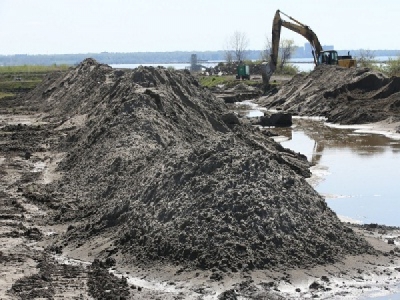
Posted on October 5, 2017
By Emily Bamforth, cleveland.com
After years of lawsuits over the dredging of the Cuyahoga River, the Ohio Environmental Protection Agency and the Army Corps of Engineers are collaborating.
Dredging has been a sticking point for years, but officials say the relationship between the Army Corps, the Port of Cleveland and the Ohio EPA has changed for the better now that Brig. Gen. Mark Toy is leading the Corps’ Great Lakes and Ohio River Division.
“We’re really happy,” Will Friedman, president and CEO of the Port of Cleveland, said. “It seems as if we’re getting into a new era.”
This could mean fewer conflicts and no stalling when it comes to removing sediment from Cleveland’s six-mile shipping channel.
What is dredging?
Dredging removes sediment from the bottom of the river, which builds up as a natural result of sand and silt in the current. Dredging the bottom of the channel regularly allows ships to move through smoothly, so ships don’t get stuck.
By law, the U.S. Army Corps of Engineers handles dredging for the Port of Cleveland. They’ll dredge to a depth of 23 feet. The group received additional federal funding this year to dredge the channel, along with other projects.
To figure out where to put the sediment, the Army Corps analyzes samples. In order to dispose of the sediment in open water – Lake Erie – the results have to show that there will be no “unacceptable adverse effect” to the ecosystem, according to the Clean Water Act.
If the tests show the sediment has material in it that could disturb the lake, the Army Corps has to dump it into a contained dike on the lakefront.
What was the problem?
There were delays in dredging in 2015 and 2016.
In 2015, the Army Corps refused to dredge the sixth mile of the channel because the state required it be dumped in the containment facility, not Lake Erie. The state sued, and a federal judge ordered the Corps to complete the dredging in May 2015. The judge then ruled in May of this year that the Army Corps must pay for the total cost of dredging and properly disposing of the settlement.
A federal judge on Friday ruled against the U.S. Army Corps of Engineers in a protracted dispute over dredging Cleveland Harbor and the Cuyahoga River shipping channel.
The Army Corps has not publicly announced whether they will appeal the ruling, but Friedman said he doesn’t believe they will.
A similar disagreement occurred in 2016, and the state sued again. The Army Corps agreed in October 2016 to dredge, and the state EPA agreed to pay the Army Corps if the state lost the lawsuit. Dredging halted in December because of mechanical breakdowns and inclement weather.
There has been no ruling in that case.
There were no delays in dredging for 2017 and no lawsuits filed over the cost.
What are they doing to work together?
Toy was chosen in August 2016.
Ohio EPA director Craig Butler called Toy a “breath of fresh air” to work with.
“He’s very engaged,” he said. “(Toy) has truly invested his time and his effort with the state of Ohio to try and get this issue resolved for the long term.”
In a phone interview, Toy said the Army Corps, Ohio EPA and other groups, including businesses like Cleveland steel company ArcelorMittal, met in April to discuss how to better communicate. Toy said he was building on a lot of work that had already been done.
“There was a need for all of us to come together to hash these issues out,” Toy said. “I am really pleased with how we’re moving forward.”
For example, the Ohio EPA and the Army Corps had disagreed on where to pull samples from in the channel, but that was resolved within a half hour, Toy said.
Sampling has already occurred for 2018.
There were no substantial changes in the process, said David Frothingham, an Army Corps environmental engineer. But the Ohio EPA and Army Corps also discussed the specific tests and applications of the Great Lakes Testing Manual, which minimizes conflict after the analysis.
“That makes it more of a black-and-white (decision),” Toy said.
In another change, instead of approving twice a year, the state EPA will issue dredging permits for both the fall and spring.
“That gives them a year to resolve issues, so they’re not always pushing up against approval deadlines,” Butler said.
Source: cleveland.com





